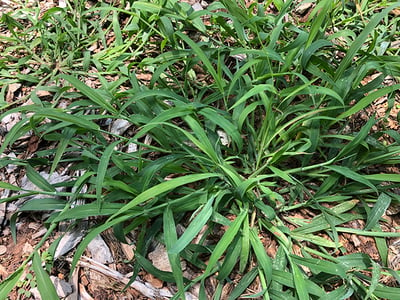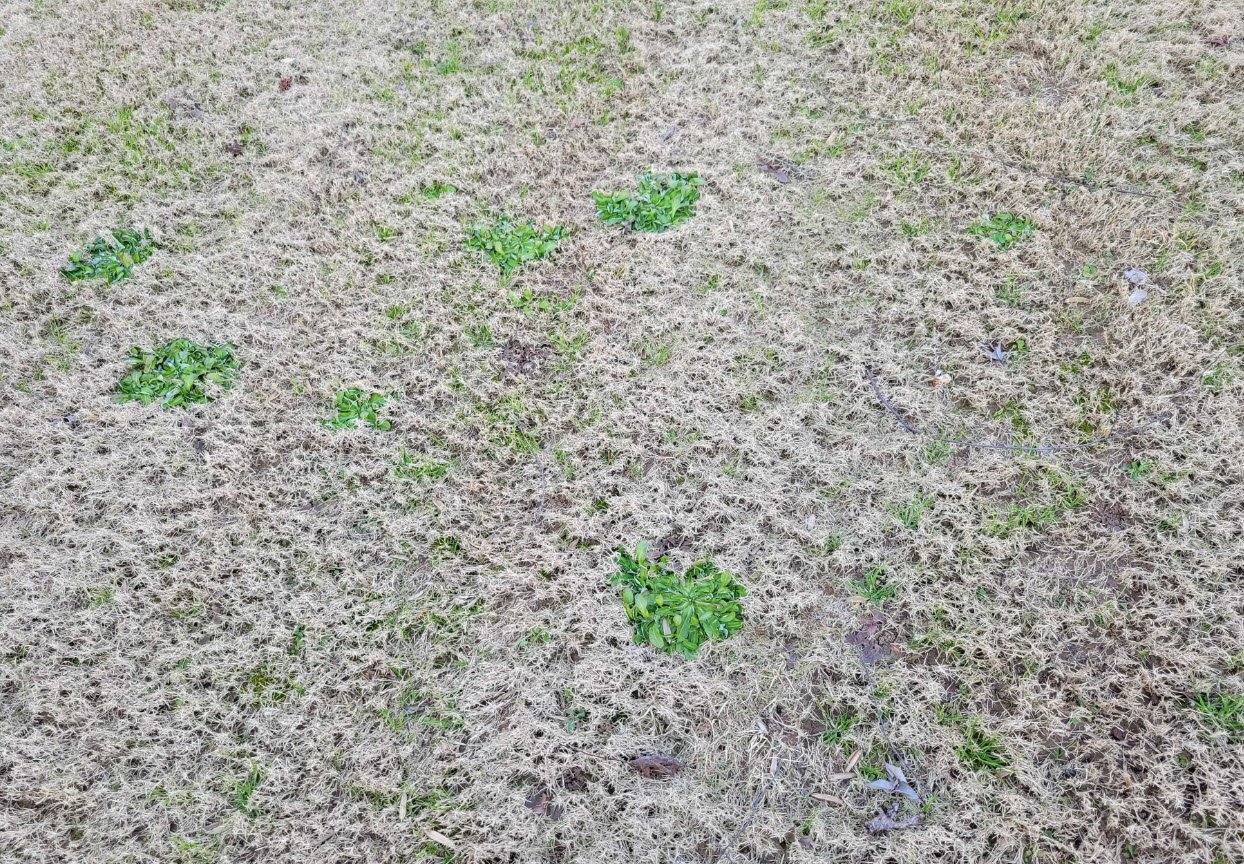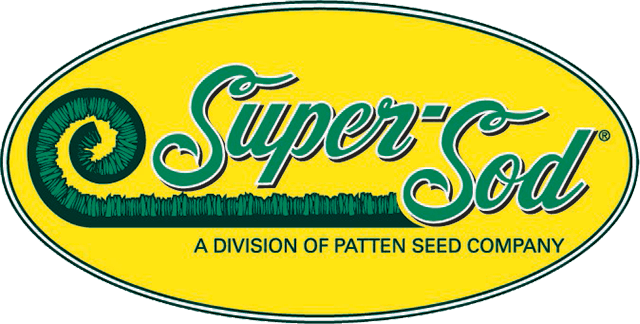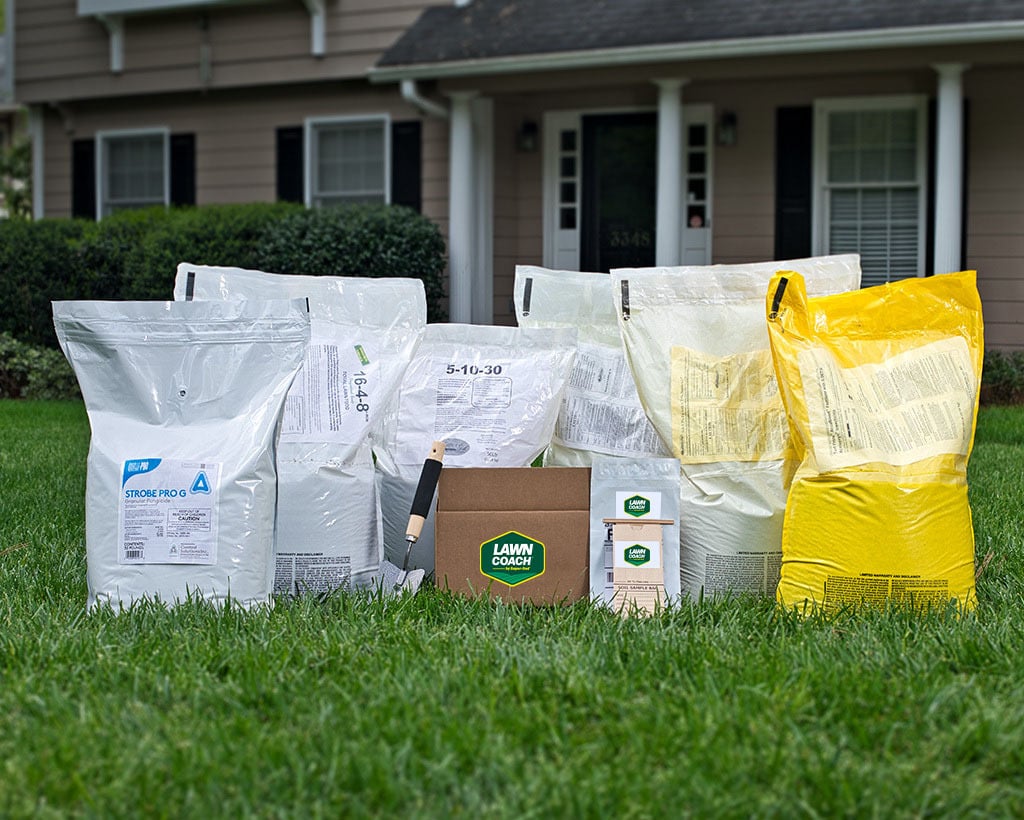

Winter might feel like a break from lawn work, but beneath the snow and frost, those of us in the South are noticing winter weeds in our lawns. Loathsome, obnoxious weeds!
In this guide, Super-Sod explains how to identify common winter weeds in lawns, why they appear when your grass is resting, and which control methods work. You’ll learn the difference between pre-emergent (prevention) and post-emergent weed control and when to treat with both types of products.
So, how do you tackle this problem of winter weeds? We've got plenty of advice for you on how to kill winter weeds.
White clover stands out in a dormant Bermuda lawn. This plant needs both pre- and post-emergent herbicide treatments for control. Photo by Kevin Kilgore, Regional Manager.

When it's Too Late for Winter Weed Prevention
We’ll start with what NOT to do. Don't apply pre-emergent herbicide in January – it will be a waste of your time and money because the weeds have already germinated. It's a waste because pre-emergent treatments must be applied before weed seeds germinate.
If you see green weeds in your brown, dormant lawn, that means they have already germinated. By January, soil temperatures are too cold for weed germination, so any pre-emergent product applied will leach out of the soil before it can provide any benefit.
Poa annua grows fast! Make sure to remove it or mow it before all those seeds spread. Photo by Hillary Thompson, Communications Director.
Effective Winter Weed Control: What Can You Do Now?
Your best course of action is to work out your frustration by hand-pulling those pesky, pernicious, propagating weeds!
- Removing: Save your money and burn some holiday calories by hand-pulling and digging! Removing weeds with the roots is really the most effective option. (Poa annua usually comes up quite easily.) Want to save your back? Hillary Thompson likes, "The CobraHead long handle weeder that saves me from stooping. This is my favorite tool, but there are other options to keep you standing while pulling out those annoying weeds."
- Mowing: For those of us with dormant lawns, mowing in January might seem silly. However, whether you are mowing your lush, green Tall Fescue or your dormant, brown Bermuda, mowing will help stop those winter weeds from making and spreading seeds. It is not as effective as pulling weeds, but depending on how prolific the weeds are, hand-pulling may be just as fast or faster.
- No Spraying (Yet): Most post-emergent herbicides applied to weeds you can see are not effective when daytime temperatures fall below 65 degrees, so spraying those chemical treatments in January will be relatively ineffectual. When we have a few warmer days (above 65 degrees) in the forecast, you can break out your pump-up sprayer. Keep in mind that it often takes more than one post-emergent herbicide application in winter.
👍 Rule of Thumb: Always make sure to carefully read the label on your herbicide products and follow the application instructions. Ensure you use an herbicide that’s approved for your grass type.
⚠️ Critical Winter Herbicide Note: Although your dormant lawn is brown, it could be adversely affected by spraying a broad-spectrum, non-selective herbicide such as glyphosate; the reason is that glyphosate kills every plant it touches (it's "non-selective"), and there might be some green growth in your lawn that you overlook. This may come as a surprise, but not all warm-season lawns go completely dormant in winter.
Identifying Your Winter Weeds
Properly identifying weeds helps determine how to control them. These are common winter weeds in the South. Click to see photos and learn more about each winter weed:
- White clover
- Poa annua or annual bluegrass
- Common chickweed
- Hairy bittercress
- Shiny cudweed
- Dead nettle and henbit
- Vetch
- Carolina geranium
- False hawksbeard
Common winter weeds (clockwise from top left): shiny cudweed, common chickweed, annual bluegrass, hairy bittercress, henbit, and dead nettle.
Fall Pre-Emergent Herbicide Not Working?
If you are wondering why you have weeds now, even though you did apply pre-emergent last fall, it may be one of two things:
- Water: To work, pre-emergent chemicals must make contact with the seeds. For granular pre-emergent, this occurs by "watering-in" after application, because irrigation/rainfall is required to activate the herbicide. On the other hand, excessive water can reduce treatment effectiveness.
⚠️ Critical Fall Pre-Emergent Watering Note: If your region experiences a rainy fall, such as from tropical storms, the heavy rains could easily leach and wash away the pre-emergent. Pre-emergent treatments may have been moved downhill or washed deeper into the soil, compromising the effectiveness in part or all of your lawn. - Timing: The timing of when you apply pre-emergent herbicide is a key factor in how well it works. If you were late applying the pre-emergent, weed seeds might have already germinated. A mild and wet fall can cause winter weed seeds to germinate earlier than usual.
👍 Rule of Thumb: The best timeframe to apply pre-emergent herbicide is from September 15 to October 15. Earlier is better than later.ToTf.
👉 Pre-emergent is a powerful tool for combating weeds, so we've written an entire blog post on the ins and outs of using it. We cover timing, temperature, and when not to apply it in this article: Pre-emergent Herbicide is our #1 Trick for Weed Control.
Stay on Schedule
Remember pre-emergent will not work on those weeds that have already sprouted. But you should prepare to apply pre-emergent in February when the Forsythia bushes flower (signaling the ground is warm enough for the pre-emergent to work). That application will reduce late spring/early summer weeds.
Frequently Asked Questions
What is the best herbicide for winter weeds?
Super-Sod recommends a granular pre-emergent herbicide program as the most effective way to prevent winter weeds from fully germinating, thus killing weeds before you even see them. The best time to prevent winter weeds is in the fall: spread the granular pre-emergent herbicide from mid-September to mid-October. For weeds that you can see, spray a liquid post-emergent, selective herbicide directly on visible weeds when daytime temperatures are above 65 degrees. Carefully read the label to ensure the post-emergent herbicide is safe for your lawn type and that it specifically targets the weeds infesting it.
What to do to control weeds during cold weather?
Super-Sod recommends hand-pulling weeds, mowing them to prevent flowering and seed production (thereby interrupting their lifecycle), and maintaining a routine pre-emergent herbicide program three times a year: in February, April, and September. Only as a backup, due to reduced liquid post-emergent herbicide efficacy during cold weather, does Super-Sod recommend spraying winter weeds with a post-emergent.
When should I spray winter weeds?
For the liquid post-emergent herbicide to work, the air temperature must be a little warmer than your typical winter day. Super-Sod recommends spraying winter weeds during warm spells when daytime temperatures are above 65 degrees Fahrenheit. Due to the colder weather, plants may not be actively growing, so a repeat application may be necessary.
How do you permanently stop winter weeds from growing?
For significantly reducing the amount of weeds you see, Super-Sod recommends following a three-times-a-year granular pre-emergent herbicide schedule: spread pre-emergent in February, April, and September. Pre-emergent is our number one trick for controlling weeds, so we've written an entire blog post covering the ins and outs of this technique; please read it here: Pre-emergent Herbicide is our #1 Trick for Weed Control.
More Information
Our master document about weed control can be found here: Weed Control for Lawns.
Still unsure what a post-emergent is vs. a pre-emergent? Read our article on Pre-Emergent, Post-Emergent, and Weed & Feed: What's the Difference?
Want us to remind you when it is time for weed control, fertilizer, or other lawn maintenance? Join our Monthly Lawn Tips email list.
Better yet, sign up for our Lawn Coach Subscription service and we will ship you the lawn treatment products you need when it is the right time to apply them.






